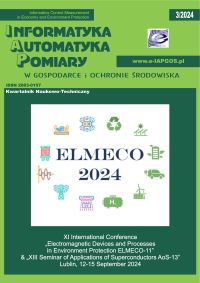UOGÓLNIONE PODEJŚCIE DO ESTYMACJI WYKŁADNIKA HURSTA NA PODSTAWIE SZEREGÓW CZASOWYCH
Lyudmyla Kirichenko
lyudmyla.kirichenko@nure.uaKharkiv National University of Radioelectronics, Deptartment of Applied Mathematics (Ukraina)
Tamara Radivilova
Kharkiv National University of Radioelectronics, Deptartment of Infocommunication Engineering (Ukraina)
Vitalii Bulakh
Kharkiv National University of Radioelectronics, Deptartment of Applied Mathematics (Ukraina)
Abstrakt
W pracy przedstawiono uogólnione podejście do analizy fraktalnej samopodobnych procesów losowych przedstawianych w krótkich szeregach czasowych. Zaproponowano kilka etapów analizy fraktalnej. Wstępna analiza szeregów czasowych obejmuje eliminację krótkoterminowej zależności, identyfikację prawdziwej długoterminowej zależności oraz weryfikację hipotezy o istnieniu własności samopodobieństwa. Uwzględniono metody bezstronnej oceny przedziału czasowego wykładnika Hursta w przypadku stacjonarnych i niestacjonarnych szeregów czasowych. Zaproponowano metody walidacji uzyskanego oszacowania wykładnika Hursta. To podejście ma zastosowanie do badania samopodobnych szeregów czasowych o różnym charakterze.
Słowa kluczowe:
samopodobny proces stochastyczny, szeregi czasowe, wykładnik HurstaBibliografia
Abry P., Flandrin P., Taqqu M.S., Veitch D.: Self-similarity and long-range dependence through the wavelet lens. Theory and applications of long-range dependence, Birkhäuser 2003.
Google Scholar
Abry P., Veitch D.: Wavelet analysis of long-range dependent traffic. IEEE/ACM Transactions Information Theory, Vol. 1(44), 1998.
Google Scholar
Bassingthwaighte J.B., Liebovitch L.S., West B.J.: Fractal Physiology. Oxford University Press, New York 1994.
Google Scholar
Ching E.S.C., Tsang Yue-Kin : Multifractality and scale invariance in human heartbeat dynamics. Physical Review E, Vol. 76, 2007, 041910.
Google Scholar
Clegg R.G.: A practical guide to measuring the Hurst parameter. Computing science technical report 2005. Vol. CS–TR–916.
Google Scholar
Cont R., Tankov P.: Financial modelling with jump processes. Chapman & Hall CRC Press, 2004.
Google Scholar
Czarkowski M., Kaczmarek S., Wolff M.: Influence of Self-Similar Traffic Type on Performance of QoS Routing Algorithms. INTL Journal of electronics and telecommunications, Vol. 62, no. 1, 2016, 81–87.
Google Scholar
Feder J.: Fractals. Plenum, New York 1988.
Google Scholar
Flandrin P., Gonzalves P., Abry P.: Scaling, Fractals and Wavelets. John Wiley & Sons, London 2009.
Google Scholar
Harikrishnan K.P., Misra R., Ambika G: Can the multifractal spectrum be used as a diagnostic tool? Chaotic Modeling and Simulation, Vol. 1, 2013, 51–57.
Google Scholar
Hurst H.E., Black R.P., Simaila Y.M.: Long-Term Storage: An Experimental Study. Constable, London 1965.
Google Scholar
Kantelhardt J.W., Koscielny-Bunde E., Rego H.H.A., Havlin S., Bunde A.: Detecting long-range correlations with detrended fluctuation analysis. Physica A 295, 2001, 441–454.
Google Scholar
Kantelhardt J.W.: Fractal and Multifractal Time Series. 2008. http://arxiv.org/abs/0804.0747 (available: 12.10.2017).
Google Scholar
Kirichenko L., Deineko Zh.: Estimation of the self-similarity of stochastic time series by the wavelet analysis method. Radio-electronic and computer systems, Vol. 4 (38), 2009, 99–105.
Google Scholar
Kirichenko L., Radivilova T., Deineko Zh.: Comparative Analysis for Estimating of the Hurst Exponent for Stationary and Nonstationary Time Series. Information Technologies & Knowledge, Vol. 5, No 4, 2011, 371–388.
Google Scholar
Kirichenko L., Radivilova T.: Comparative analysis of statistical properties of the Hurst exponent estimates obtained by different methods. Information Models of Knowledg. ITHEA, Kiev–Sofia 2010.
Google Scholar
Kirichenko L., Radivilova T.: Investigation of long-term dependence of network traffic using R / S-analysis. Automated control systems and automation devices, Vol. 135, 2006, 51–55.
Google Scholar
Meléndez G.R.: The fractal nature of bitcoin: evidence from wavelet power spectra. Fundacion Universidad de las Americas Puebla 39, 2014. http://ssrn.com/abstract=2547281 (available: 12.10.2017).
Google Scholar
Peng C.-K., Buldyrev S.V., Havlin S., Simons M., Stanley H.E., Goldberger A.L.: Mosaic organization of DNA nucleotides. Phys. Rev. E 49, 1994, 1685–1689.
Google Scholar
Peters E.E.: Fractal Market Analysis: applying chaos theory to investment and economics. Wiley, 2003.
Google Scholar
Sheluhin O.I., Smolskiy S.M., Osin A.V.: Self-similar processes in telecommunications. JohnWiley & Sons Ltd, Chichester 2007.
Google Scholar
Stollings W.: High-speed networks and Internets. Performance and quality of service. New Jersey 2002.
Google Scholar
Tsugawa S., Ohsaki H.: Emergence of Fractals in Social Networks: Analysis of Community Structure and Interaction Locality. 38th Annual Computer Software and Applications Conference, 2014
Google Scholar
Willinger W., Taqqu M.S., Erramilli A.A.: Bibliographical guide to self-similar traffic and performance modeling for modern high-speed network in ″Stohastic networks: theory and applications″. Claredon Press (Oxford University Press), Oxford 1996.
Google Scholar
Autorzy
Lyudmyla Kirichenkolyudmyla.kirichenko@nure.ua
Kharkiv National University of Radioelectronics, Deptartment of Applied Mathematics Ukraina
Autorzy
Tamara RadivilovaKharkiv National University of Radioelectronics, Deptartment of Infocommunication Engineering Ukraina
Autorzy
Vitalii BulakhKharkiv National University of Radioelectronics, Deptartment of Applied Mathematics Ukraina
Statystyki
Abstract views: 431PDF downloads: 201
Licencja

Utwór dostępny jest na licencji Creative Commons Uznanie autorstwa – Na tych samych warunkach 4.0 Miedzynarodowe.








